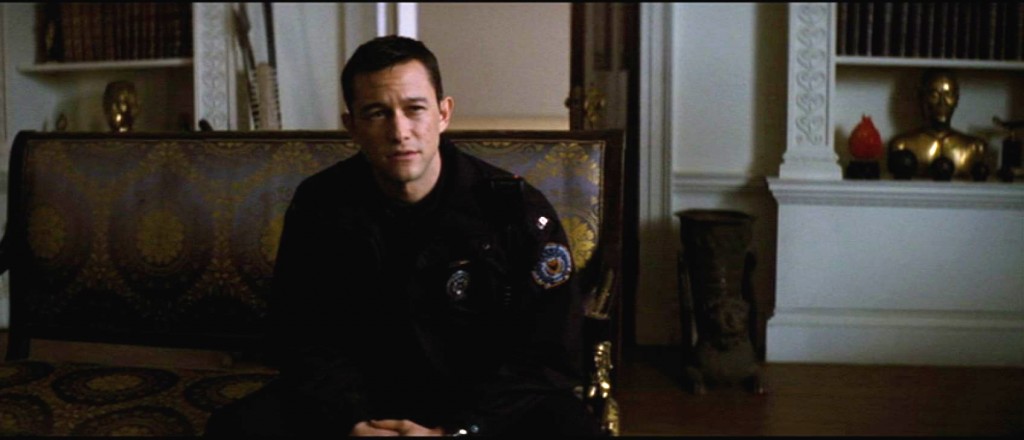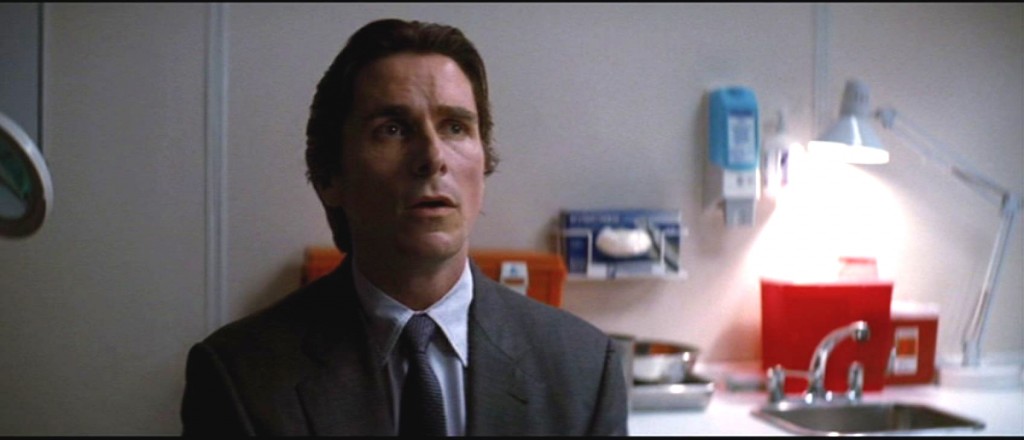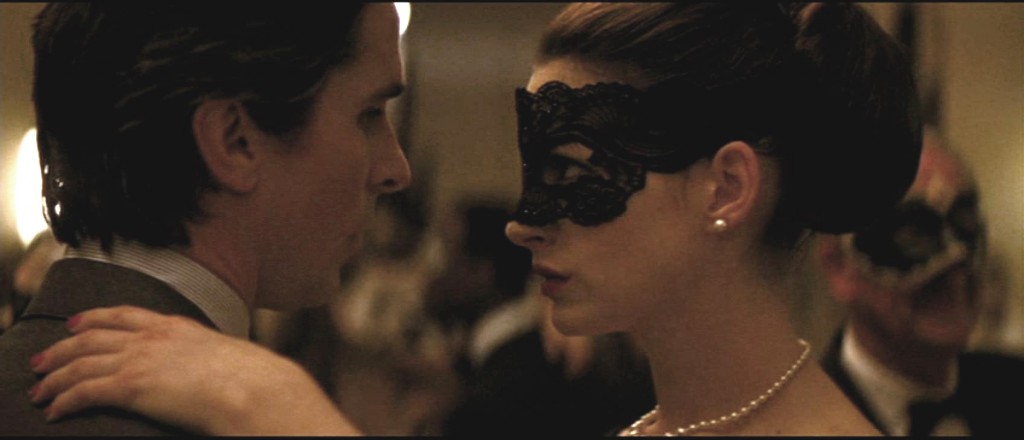Batman: The Dark Knight Rises part 4
With Jim Gordon hospitalized, John Blake emerges as a significant secondary protagonist in The Dark Knight Rises a kind of “young Gordon.” What does Blake want? Blake wants Bruce Wayne to stop sitting around feeling sorry for himself and become Batman again.
Now then. Some have expressed discomfort with the idea that John Blake, Rookie Cop, knows that Bruce Wayne is Batman while neither Jim Gordon nor any other citizen of Gotham City has apparently even given the matter a moment’s thought. This, for me, goes hand in hand with other narrative contrivances that occasionally poke through the cloth of Nolan’s Batman trilogy. The presentation and production design of these movies is so grounded, so realistic, it’s easy to forget Batman’s pulp roots, nay his operatic roots, and moments like “Blake knows Bruce Wayne is Batman,” in my experience, are endemic to the genre. I’ll say it again, the moment you decide to make a movie about a man who dresses up like a bat to fight crime, you enter the realm of the fantastic. The reader may remember my analysis of Batman and Robin, where I discovered that the psychedelic outrages of that screenplay all stem from the choice of making the flamboyantly fantastical character Mr. Freeze the chief antagonist of the piece — once that decision was made, everything else had to be made that much more crazy to fit that character. A similar thing happens here: as much as director Nolan wants to ground his Batman movies, the fact remains that they are about a man who dresses up as a bat to fight crime. Thousands of creative and narrative choices flow from that single plot point. Since that single plot point is flat-out absurd, it greatly affects everything that flows from it. In this case, wait, why hasn’t anyone, anywhere, even tried to figure out who Batman is? If a movie tried to address that question in any realistic way we’d be here all day, and the narrative would quickly spiral out of control as the thousands of questions raised by a man dressing up as a bat to fight crime would echo down and down and down until the very thing we get out of a Batman story — that is, the metaphor — would be lost. That’s why narratives like The Dark Knight Rises needs occasional contrivances like “Rookie Cop Figures Out Bruce Wayne is Batman” (or “SEC Approves Trades Made By Terrorists at Stock Exchange”). Anyone whose disbelief crashes down at this juncture would fall down dead if the same everyday logic was pressed onto any other aspect of the narrative.
So yes, John Blake comes to Wayne Manor, for he has figured out that Bruce Wayne is Batman, and he confronts him about that. Blake is in some ways the anti-Bruce — also an orphan, but with none of the ameliorating comforts of, for instance, billions of dollars. Blake’s parents, unlike Bruce’s, were not killed as a direct result of Gotham City’s lawlessness, but he has suffered the same feelings of injustice and rage, and experienced the same inability to move past his childhood trauma. His monologue to Bruce grounds the narrative, again, in the vocabulary of realistic drama by equating the mask Bruce wears as Batman with the mask Blake wears as a well-adjusted grownup. A billionare, he notes, doesn’t have to dress up like a bat to garner legends to himself — the money alone takes care of that (as we’ve seen earlier in the party sequence, with everyone buzzing about “what’s really going on with Bruce”). It also serves as a reminder, as hinted at above, that the smallest decisions of the wealthy have massive impact on the poor. Finally, it reminds us that the central message of Nolan’s Batman movies is that Batman isn’t a man, he’s a symbol, a symbol of darkness against the darkness, that Bruce Wayne, in the end, isn’t Batman, Batman is an idea that asks each of us to use our anger at injustice to force positive societal change.
(Batman’s mask is, of course, the primary psychological metaphor of the character concept — at least nowadays. And it’s often been said that Batman is the real guy and Bruce Wayne is the mask, but did Bob Kane think of it that way when he created the character in 1939 or is that something that has been slowly layered on over the decades? In any case, in the movies, Bruce-as-mask dates back to Tim Burton’s 1989 Batman and has remained central to the concept ever since.)
Narratively, Blake’s visit to Bruce propels Act I into Act II. Bruce’s goal in Act I is “to hide,” but Selina tickles his interest and now Blake has rekindled it. A minute-long conference with Alfred confirms that Bane and his mercenaries are working for yet-another-anti-Bruce John Daggett (a businessman with money but no morals) and launches Bruce into Dark Knight mode — to the extent that he can. If Bruce’s Act I want is “to hide,” his Act II want is “to prepare.”
Bruce goes to the doctor, who tells him his health is shot, then puts on the worst-ever Temp Batman outfit to go visit Gordon, who, like Blake, presses upon Bruce the need for the Batman to return (or rise, if you must) against the “evil” that Bane is preparing to foist upon the city.
Step two in Bruce’s comeback campaign is to attend a charity ball, intent on tracking down his mother’s pearls (which Selina is wearing). But before he can get to Selina he runs into Miranda Tate (“Miranda” — after the most well-known accused-rights act?) and reveals a shocking anti-charity opinion. Charity, he says, exists to help the charitable feel better about themselves, to raise their profile among the wealthy, not to help the needy. Bruce, of course, is a prominent philanthropist (until recenty anyway), but his stance nevertheless points to his notions of societal change, which he makes with his fists and with total physical commitment. Miranda drops a line about “our clean-energy project,” for expository purposes, but she also becomes the third person to provoke Bruce to action. She accuses him of apathy and immaturity in the face of failure, talking about this mysterious plot-point “save the world” project but also underlining, of course, his commitment to society as Batman. One of the questions Rises asks is “When has Bruce given enough?” but another is “What is enough?” What do we owe to society, and what does society owe to the individual?
Selina, an anti-Miranda (and also another anti-Bruce) dances with Bruce, literally and wit-wise, and takes the opportunity to justify herself to him. Miranda is a philanthropist and Selina is a thief, but they’re both interested in the transference of wealth to effect societal change. (Bruce is also interested in the transfer of wealth to effect societal change, but in his case the wealth is mostly transferred to whoever manufactures the cool gadgets Lucius Fox designs to help him beat up criminals.) Selina’s beef is that (shades of Fantine!) one can never be free of one’s past, and in her case that means stealing (and working with dangerous people) in order to escape her chosen-by-society identity. Like Blake mentions earlier, identity is always a mask, Bruce and Selina just make that mask literal. Bruce wants to escape not just his Batman identity but also his Bruce identity, Blake wants to escape his angry-orphan identity, Selina wants to escape her bad-girl identity, Bane — like the Joker — has managed to escape his literal identity, much in the same way the Ra’s Al-Ghul of Begins escaped his identity through transference into legend, bringing us back to Bruce and his decision to turn himself into a symbol. Selina also seems to have a beef against the wealthy of Gotham City, as she hisses threats into Bruce’s ear about an incoming class war, then kisses him and, while he’s thinking about that, steals his car keys. Batman uses his fists to effect change, but Selina uses what comes naturally to her — her wiles.



I figured that Bruce Wayne being Batman was a healthy conspiracy theory, ever since that guy from Wayne Tech talked about it on television in the previous film, but most people stopped caring eight years ago. Gordon never let himself speculate because he has an interest in not killing the golden goose. (The black bat?)
Miranda is probably a reference to Shakespeare’s The Tempest – the daughter of a powerful wizard.
Ah yes, that Miranda. I wonder how deep that goes, since Miranda is the daughter of a duke who was usurped by his brother and cast out to sea.
People who get cast out to sea: Batman Begins, Ra’s dunks Bruce through the ice when they’re training. (The League of Shadows is a fraternity, which does make Ra’s and Bruce brothers of a sort.)
The Dark Knight Rises, all the people who get tossed out onto the ice; Batman when he takes the bomb out to sea.
I think The Tempest is an important reference here–not just for Selina’s whole “a storm is coming” speech–but for the Calibanic aspects of this version of Bane. In the comics, Bane was originally a self-motivated villain, whereas here he becomes merely the twisted servant. So for this Miranda-gone-bad, Caliban becomes the natural ally and Ariel becomes the rebellious servant. Which is pretty much what Selina Kyle is–the erstwhile ally/servant who switches sides.
Nice. It’s been a while since I read The Tempest, but yes, this all scans.
This “Rookie Cop Figures Out That Bruce Wayne Is Batman” angle has always bothered me – but in the opposite way. I love how people who consider themselves steeped in Batman lore love to cry foul at this scene, when, in the comics, NINE-YEAR-OLD Tim Drake (the third Robin) is able to deduce Bruce and Dick Grayson’s identities as crimefighters when seemingly no one else can. John Blake shares many characteristics with Tim Drake (hey, their names even rhyme!), which makes him a prime candidate to take on the mantle of the Bat. Yes, it’s a bit farfetched, I’ll give you that. But it fits in well with comic book continuity. Basically, though, people will look for any reason to complain.
Oh nice, I didn’t know that about Tim Drake, I only know him through the Bruce Timm show.
I think Blake figuring it out is what John Scalzi has dubbed a “Flying Snowman.” (Background: some animated holiday special was on TV, and his wife complained that the snowman was flying. For whatever reason, she was okay with it walking around and talking and doing a hundred other things snowmen can’t do, but flying — that was simply a bridge too far. As Scalzi noted, one person’s reasonable suspension of disbelief can be another’s Flying Snowman, depending on individual preference.)
For me, it works, because it feels like the point being made is meant to be psychological, rather than rational. Gordan doesn’t ID Batman because Gordon has nothing in common with him (or with Bruce Wayne). But Blake has the right sort of trauma in his past to recognize a kindred spirit. You can’t know Batman unless you’ve walked a mile in his shoes, etc — which is particularly relevant given where the story is going with Blake. And while it’s true that Nolan has tried to ground his Batman as deeply in realism as possible, he’s also dug pretty heavily into the psychological implications of the premise, so having the logic here be based on that aspect makes sense.
The thing that I like about Gordon’s relationship with Batman is that he doesn’t realize that he helped create Batman by helping Bruce that dark night when he was eight. Gordon was there to inspire, he’s a man who looks forward. It, apparently, never occurred to him to go over his memories to try to figure out why a vigilante who is also obviously a billionaire would build a special trust with a specific police detective.
How many Acts do you see THE DARK KNIGHT RISES as having? I note that here we’re at the transition between Act 1 and Act 2, and Bruce has still yet to become Batman (again).
I think this has come up before, but it’s interesting to me to compare the levels of fantasy in something like the James Bond series vs. superhero movies. Heroes with superpowers (ex. Spiderman, The Hulk, the X-Men) are theoretically less realistic than heroes without superpowers (ex. Batman, Iron Man), which are theoretically less realistic than James Bond. That’s not to say that most James Bond movies are particularly realistic (or in the case of MOONRAKER et al, even remotely realistic), but they have a toehold in reality that superhero movies don’t.
It’s like superhero stories are basically impossible, while Bond films are just highly implausible.
My guess is that Rises has four acts, like its predecessor.
James Bond only occasionally steps into the realm of the real, and he is carefully designed for that purpose. There are moments that ground him in reality, and occasionally there’s a movie like For Your Eyes Only that take a serious stab at putting him into a realistic espionage narrative, but for the most part the Bond movies operate totally within their own logical universe.
I dunno. The idea that the SEC would allow blatant criminal fiscal wrongdoing to occur without so much as a harrumph is one of the least fanciful things presented.
Burn!
I’d like to put it out there: one of you mentioned that Blake resembles Tim Drake in that he deduces Batman and Robin’s identities, the third to take up the mantel of ‘Robin’ and then be becomes Red Robin, also heralded as a great detective. Not only that, but, like Dick Grayson, he is a cop and an orphan (Jason Todd was also and orphan who spent time in a boy’s home, unlike Dick who was basically immediately taken on by Bruce.
Bale once stated that he’d never be Batman in a film featuring Robin in the sense that most are wont to think of Robin. Essentially, Robin John Blake is the Amalgamation of the first three(of five total) Robins, though he bears the most resemblance to Dick Grayson. It’s a fan service (a much welcomed one) and a deserved homage to a really beloved character, as well as just a damn sneaky way to foil Bale’s statement. In the end, however, it is Blake who carries the legacy. Batman the image has not face, just a mask. Three times, Dick Grayson took on the cowl, one time in near permanence after the death of Bruce. He helps to round out and appease the rules of a trilogy, reconnecting to the first film, bringing everything full circle. He is Bruce from Begins, he is angry and hurting and ideologically passionate. He wants to bring change, and he doesn’t see it happening. He will not carry the torch and enforce the entire point of the Nolan Dark Knight trilogy: the world is what we make it. We are – each and every one of us – the Batman. We are the change we want to see in the future. Our names are not important, it is rather the outcome of our actions that matters the most.
Christian Bale agrees with you.
About Joseph Orphan Levitt’s deduction, I don’t have any particular problem with that as a choice, but it raises some questions, both thematically and logically.
For instance, if all you need to deduce Batman’s identity is to be orphaned (and maybe join the police force), why isn’t there an army of orphans who flock to Wayne Major to join up? (We see just such an army of Batmen in the comics a few times, like in The Dark Knight Returns.) I mean this seriously: as others have noted, Batman’s powers are largely learnable or bought, which brings us back to the opening scene of the second movie, when Batman tells a wanna-be vigilante that the difference between them is that Batman “isn’t wearing hockey pads.” Well hell, Bruce–why not recruit those schlubs and give them real armor and training? So this moment doesn’t make me recoil because Blake figured out what no one else coud, but because it opens up too many questions about Bruce Wayne’s really dumb choices in life.
As for the choice of Mr. Freeze leading Batman and Robin into a silly place, I think the counter-argument is the animated series episode “Heart of Ice,” which keeps a lot of the silliness, like all the ice/cold puns, but manages to make Mr. Freeze’s story engaging and grounded.
Not to mention Sub-Zero, which also works better than Batman and Robin.
It just occurred to me… that Miranda “accuses [Bruce] of apathy and immaturity in the face of failure” is also a callback to BEGINS, in which Ducard/Ra’s helps to forge Bruce’s identity as Batman. Ra’s, more than anyone, helped Bruce to focus his anger and face his fears head on, and also made the case that it was Thomas Wayne’s failure “to act” that brought about his death. (This echoes later, when Bruce says to Alfred that “People need dramatic examples to shake them out of apathy.”) You might also say, as you hinted at, that Miranda’s “save the world project” is a direct reference to Bruce’s Batman project.
Miranda spends so much of the movie referencing her father, in fact (she also says, “You have to invest to restore balance to the world,” and then, later, “Do what’s necessary,” when Bruce returns to Gotham), that I’m amazed the World’s Greatest Detective doesn’t pick up on it.
Yeah, Batman’s detective skills are in severe remission in TDKR.